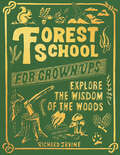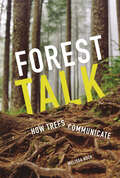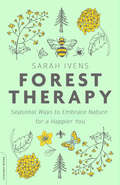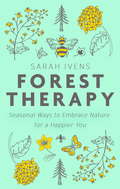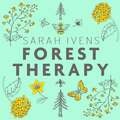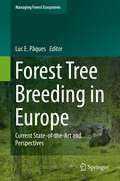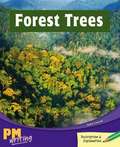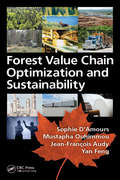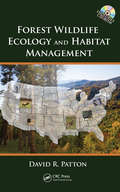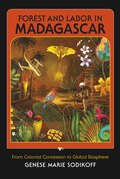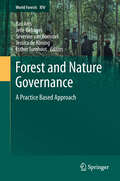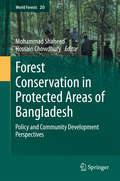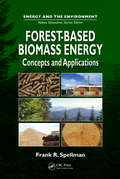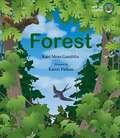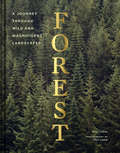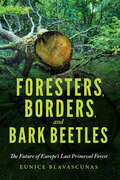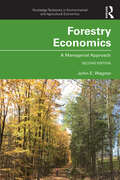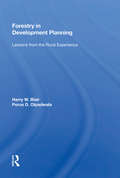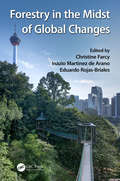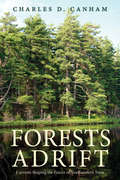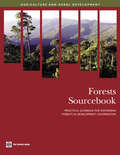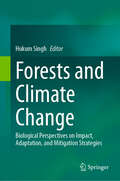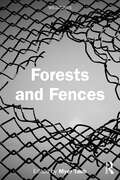- Table View
- List View
Forest School for Grown-Ups: Explore the Wisdom of the Woods
by Richard IrvineFrom starting a fire to foraging for food, basket making to making a bird feeder, tree hugging and cloud scrying, this beautifully designed forest almanac is a treasure for anyone who loves the outdoors.Forest schools for kids originated in Scandinavia as outdoor play-based learning groups, and in 2016 The Forest School Foundation was established in the USA. But why should kids have all the fun? Connecting with green spaces, trees, and plants can lift our spirits, lower our stress levels, and relax our brains – in short, playing outside is good for adults, too.Forest School for Grown-Ups is here to help. A gorgeous and comprehensive guide to all things outdoors for anyone who loves being in and interacting with nature, readers will learn how to make a rope sing, go forest bathing, read flowers, build a campfire, and make a forest potion. From practical tips and how-tos to forest folklore, there's something for everyone.Exquisite lino cut art and illustrations run throughout, along with step-by-step instructions, diagrams, and more. Forest School for Grown-Ups provides the perfect resource for people of all ages to enjoy spending quality time outdoors. From starting a fire to foraging for food, basket making to making a bird feeder, tree hugging and cloud scrying, this beautifully designed forest almanac is a treasure for anyone who loves the outdoors.HANDY AND INFORMATIVE: Comprehensive collection of all things trees, loaded with practical content with a rich, powerful design, making it the perfect gift for anyone who loves the outdoorsBEAUTIFUL AND DISTINCTIVE: Features unique handmade linocut art.FAMILY-FRIENDLY: Family-friendly, for all agesPerfect for:• Anyone who loves the outdoors, camping, trees, and nature• Father's Day, birthday, and holiday gift-givers
Forest Talk: How Trees Communicate
by Melissa KochTrees are essential. They provide water, shelter, and food for millions of plant and animal species, including humans. They deliver proven health benefits, and they capture and store carbon, which combats climate change. Yet trees are in trouble. Forests are struggling to adapt to climate change, and deforestation is a major threat. Recently, researchers and citizen scientists made the surprising revelation that trees communicate with each other through an underground system of soil fungi and other methods. Complex social networks help trees survive and thrive by transferring resources to each other, sending defense signals, communicating with their kin, and more. Meet the tree scientists and learn more of their fascinating discoveries.
Forest Therapy: Seasonal Ways to Embrace Nature for a Happier You
by Sarah IvensYour practical guide to better health, stronger relationships, and a happier life--by reconnecting with nature There is something simply soul-soothing about being in nature. In fact, research shows that spending time outside can improve the immune system, combat stress hormones, lower blood pressure, and boost self-esteem. Around the globe, rising movements are driving us to reconnect with Mother Nature--from shinrin-yoku ("forest bathing") in Japan to friluftsliv ("open-air life") in Scandinavia--yet our everyday lifestyles have distanced us from the great outdoors. For stressed-out professionals, reclusive bookworms, worn-out parents, and their cooped-up kids, Forest Therapy shares why getting back to nature is critically important for our well-being, and offers fun, easy practices to break out of hibernation.Forest bathing is a rising trend, but what to do if you're not near the woods or if the weather is dreary? Forest Therapy offers practical steps and inspiration to tap into nature's restorative power, no matter the season or the weather. Chapters address ideas for all four seasons, as well as ways to use experiences in nature as ways to deepen your relationships with your children, partner, and friends. Ivens's creative ideas and strategies range from a simple walk in the woods and countryside couples' therapy to DIY natural beauty products and simple ways to bring the great outdoors into your home. Illustrated with charming black-and-white line art, Forest Therapy is a warm, witty, and personal guide to improving your health, finding happiness, and living a fabulous al fresco life.
Forest Therapy: Seasonal Ways to Embrace Nature for a Happier You
by Sarah IvensWho hasn't felt better after a walk in the woods, a picnic alfresco or a swim in the sea? There is something soul-soothingly simple and refreshing about getting back to nature, about making the most of the great outdoors, being mindful of Mother Nature's gifts and grabbing spring and summer - and those blue sky, brisk days of autumn and winter - with both hands. But sadly it is a skill we are losing. We are becoming creatures wrapped in walls and trapped by to-do lists, hibernating while the world sprouts, grows and changes.From a simple walk in the woods and countryside couples therapy to DIY natural beauty products and how to bring the outdoors to your home, Forest Therapy will provide seasonal tips to help you reconnect with nature. This book is not just for mountain climbers or white water rafters - it is for uninspired fathers wanting to reconnect their families, bookworms looking to shake off their cobwebs, cooped-up kids needing to let off steam, stressed-out professionals wanting to stop and smell the flowers and worn-down mums needing a rejuvenating boost. We all know getting outside is good for us. Our ancestors did it. We should too. This book will help you live your most unforgettable, fabulous alfresco life.
Forest Therapy: Seasonal Ways to Embrace Nature for a Happier You
by Sarah IvensWho hasn't felt better after a walk in the woods, a picnic alfresco or a swim in the sea? There is something soul-soothingly simple and refreshing about getting back to nature, about making the most of the great outdoors, being mindful of Mother Nature's gifts and grabbing spring and summer - and those blue sky, brisk days of autumn and winter - with both hands. But sadly it is a skill we are losing. We are becoming creatures wrapped in walls and trapped by to-do lists, hibernating while the world sprouts, grows and changes.From a simple walk in the woods and countryside couples therapy to DIY natural beauty products and how to bring the outdoors to your home, Forest Therapy will provide seasonal tips to help you reconnect with nature. This book is not just for mountain climbers or white water rafters - it is for uninspired fathers wanting to reconnect their families, bookworms looking to shake off their cobwebs, cooped-up kids needing to let off steam, stressed-out professionals wanting to stop and smell the flowers and worn-down mums needing a rejuvenating boost. We all know getting outside is good for us. Our ancestors did it. We should too. This book will help you live your most unforgettable, fabulous alfresco life.
Forest Tree Breeding in Europe: Current State-of-the-Art and Perspectives
by Luc E PâquesForest tree breeding has been ongoing for more than 70 years across Europe. It has successfully generated improved varieties for the major economical forest tree species. They are part of the present European forestry landscape and largely contribute to intensive wood production and other forest activities. In this book, we describe the state-of-art of breeding for the main forest tree species. We provide a comprehensive, unique and up-to-date overview of the major scientific results and breeding achievements gathered from the many programmes scattered across Europe. The book is divided into 10 chapters, each as a monograph corresponding to a species or group of species Abies spp., (Larix spp., Picea abies, Picea sitchensis, Pinus sylvestris, Pseudotsuga menziesii, and Mediterranean pines; Acer pseudoplatanus, Fraxinus excelsior, and Prunus avium). Each of them is written by a group of experts and focuses on the distribution and economical importance of the species; motivation for breeding and breeding objectives; intraspecific genetic variability, breeding populations and breeding strategy; forest reproductive material deployment including mass-propagation and, prospects and perspectives for joint research and breeding. The book is a unique and up-dated source of information for students, researchers and professionals interested in the genetics and domestication of forest tree species.
Forest Trees (Into Reading, Level O #56)
by Sally Cowan Andrew LoueyNIMAC-sourced textbook <p><p> A giant has been discovered deep in the forests of Tasmania. How did it come to be? Are there others like it? And why is this giant—measuring in at just under 100 meters tall—called Centurion?
Forest Value Chain Optimization and Sustainability
by Sophie D’Amours, Mustapha Ouhimmou, Jean-François Audy and Yan FengThis book provides a global perspective on the various issues that the industry has to face as well as to provide some key global strategies that can help coping with those global challenges, such as collaboration, strategic value chain planning, and interdependency analyses. It presents literature reviews, strategic research orientations, assessment of some current key issues, and state-of-the-art methodologies.
Forest Wildlife Ecology and Habitat Management
by David R. PattonAcross the continental United States, one can identify 20 distinct forest cover types. Most of these are to be found on federal lands managed by the U.S. Forest Service and Bureau of Land Management. Those responsible for the management of trees that form the 20 different cover types and the diversity of forest wildlife that reside in them must hav
Forest World
by Margarita EngleFrom award-winning author Margarita Engle comes a lively middle grade novel in verse that tells the story of a Cuban-American boy who visits his family’s village in Cuba for the first time—and meets a sister he didn’t know he had.Edver isn’t happy about being shipped off to Cuba to visit the father he barely knows. The island is a place that no one in Miami ever mentions without a sigh, but travel laws have suddenly changed, and now it’s a lot easier for divided families to be reunited. Technology in Cuba hasn’t caught up with the times, though, and Edver is expecting a long, boring summer. He was NOT expecting to meet a sister he didn’t know he had. Luza is a year older and excited to see her little brother, until she realizes what a spoiled American he is. Looking for something—anything—they might have in common, the siblings sneak onto the Internet, despite it being forbidden in Cuba, and make up a fake butterfly. Maybe now their cryptozoologist mother will come to visit. But their message is intercepted by a dangerous poacher, and suddenly much more than their family is at stake. Edver and Luza have to find a way to overcome their differences to save the Cuban jungle that they both have grown to love.
Forest and Labor in Madagascar: From Colonial Concession to Global Biosphere
by Genese Marie SodikoffA study of the demands of economic development and ecological conservation on the African island country.Protecting the unique plants and animals that live on Madagascar while fueling economic growth has been a priority for the Malagasy state, international donors, and conservation NGOs since the late 1980s. Forest and Labor in Madagascar shows how poor rural workers who must make a living from the forest balance their needs with the desire of the state to earn foreign revenue from ecotourism and forest-based enterprises. Genese Marie Sodikoff examines how the appreciation and protection of Madagascar’s biodiversity depend on manual labor. She exposes the moral dilemmas workers face as both conservation representatives and peasant farmers by pointing to the hidden costs of ecological conservation.“Sodikoff takes us deep into the underbelly of conservation in one of the world’s biodiversity “hot-spots.” It is a world of timber barons, logging gangs, corrupt state functionaries, international conservation experts, worker-peasants, and poachers. She paints eastern Madagascar as a frontier of dispossession, exploitation, and violence. The plundering of the Mananara protected area is seen, in a brilliantly original way, from the subaltern vantage point of forest workers and conservation labor. Forest and Labor places present day conservation on the larger canvas of a century of forest-based social relations of labor that have entered into the making of what Sodikoff calls neoliberal conservation. It is a magnificently rich historical and ethnographic accounting of what passes as the making of global biosphere reserves. A tour de force.” —Michael Watts, UC Berkeley“An important and lively contribution to the study of “green neoliberalism.” An obvious choice for undergraduate teaching on ecology, rights, international political economy, development, and a host of other topics.” —David Graeber, University of London“Brings a whole new angle and nuance to the crucial debates over conservation and development. Applicable not just to lush, humid eastern Madagascar, but all around the globe.” —Christian Kull, Monash University“Those interested in conservation, tropical rainforest ecology, international political economy, and sustainable development will find Forest and Labor in Madagascar an insightful case study.” —Choice
Forest and Nature Governance
by Jelle Behagel Bas Arts Jessica De Koning Esther Turnhout Séverine Van BommelToday, problems such as deforestation, biodiversity loss and illegal logging have provoked various policy responses that are often referred to as forest and nature governance. In its broadest interpretation, governance is about the many ways in which public and private actors from the state, market and/or civil society govern public issues at multiple scales. This book takes a fresh perspective on the study of forest and nature governance. Departing from 'practice theory', and building upon scholars like Giddens, Bourdieu, Reckwitz, Schatzki and Callon, it seeks to move beyond established understandings of institutions, actors, and knowledge. In so doing, it not only presents an innovative conceptual and methodological framework for a practice based approach, but also rich case studies and ethnographies. Finally, this book is about how actors involved in governance talk about and work with trees, forests, biodiversity, wildlife, and so on, while acting upon forest policies, environmental discourses, codes of conduct, or scientific insights.
Forest conservation in protected areas of Bangladesh
by Mohammad Shaheed Hossain ChowdhuryThis book dealt with a number of issues under the broad subject matter of protected area focusing on the policy of collaborative management as a means to augment the forest conservation activities and enhance community development in Bangladesh. Studies covered in the book emerged with the success stories of protected area co-management, both in terms of community development and biodiversity conservation. Significant level of development was noticed in the socio-economic conditions of the surrounding communities. Empowerment and improved social dignity of women participants signifies the initiation of co-management approach. The principles of participatory governance were found reasonably well reflected in legal and policy frameworks. Based on the lessons from the studies, a general metaphysical model, namely 'Spider-web model of protected area co-management' has been developed that can be potentially applicable in countries where local communities rely heavily on protected areas.
Forest-Based Biomass Energy: Concepts and Applications (Energy and the Environment)
by Frank SpellmanWhat is forest-based biomass energy and why should we care? Written by environmental expert Frank Spellman, Forest-Based Biomass Energy: Concepts and Applications details how forest biomass can be converted to energy and energy products, including direct combustion, pellets, gasification, and co-firing. It explores the possibilities of forest-based
Forest: A See to Learn Book (See to Learn #1)
by Kate Moss GamblinForest: A See to Learn Book is the first book in a series of non-fiction picture books for very young children, using lyrical phrasing to encourage a sensitive perception of the natural world and a caring connection with it.Through gentle questions, the text asks young readers to consider what they see and experience in the forest through the seasons — animal tracks, tiny creatures in the soil, birds soaring in the sky above, towering trees, shade and dappled sunlight — drawing local connections alongside those of a global sensibility.Stunningly beautiful illustrations show a child and grownup exploring the forest, appreciating its beauty, learning its secrets and enjoying moments of wonder, all first steps toward developing a lifelong awareness of our interconnectedness to the Earth and our impact on the environment.Key Text Featuresauthor’s noteCorrelates to the Common Core State Standards in English Language Arts:CCSS.ELA-LITERACY.RL.K.1With prompting and support, ask and answer questions about key details in a text.CCSS.ELA-LITERACY.RL.1.4Identify words and phrases in stories or poems that suggest feelings or appeal to the senses.CCSS.ELA-LITERACY.RL.1.5Explain major differences between books that tell stories and books that give information, drawing on a wide reading of a range of text types.
Forest: Walking Among Trees
by Matt CollinsBrimming with engaging writing and stirring photography, Forest is an ode to the natural world and a celebration of the relationship between humans and trees.Discover the secrets hidden within the Earth's lush woodlands and wild landscapes through photographs and stories about enchanting forests, magnificent trees, and people who live off the land.Journeying across North America, the United Kingdom, and Europe, writer Matt Collins and photographer Roo Lewis capture the history, science, and human stories behind some of the most enchanting natural environments in the world. • Explores the captivating history behind some of the world's most enchanting forests• Organized by tree species, including the hearty pines in Spain's Tamada forest, the towering firs of the American West, the striking Birch groves of Germany's Elbe Valley, and beyond• A blend of beautiful photographs, scientific trivia, and engaging human storiesForest is an arresting tribute to the magnificence of the natural world and a wonderful gift for anyone who enjoys spending time in the outdoors.Complete with gorgeous photography and engaging stories of people living in harmony with nature, readers will learn everything they dream of knowing about the forests of the world. • A handsome gift for photographers, travel and outdoor enthusiasts, environmentalists, and science lovers• A stunning way to learn about the world and the trees that surround us• Great for readers who couldn't get enough of The Hidden Life of Trees by Peter Wohlleben, Ancient Trees by Beth Moon, and Wise Trees by Diane Cook and Len Jenshel
Foresters, Borders, and Bark Beetles: The Future of Europe's Last Primeval Forest
by Eunice Blavascunas“A compelling investigation of the pasts and possible futures of a critical ecosystem in an era of globalization and rising nationalism.” —Andrew S. Mathews, author of Instituting NatureIn Europe’s last primeval forest, at Poland’s easternmost border with Belarus, the deep past of ancient oaks, woodland bison, and thousands of species of insects and fungi collides with authoritarian and communist histories.Foresters, biologists, environmentalists, and locals project the ancient Bialowieza Forest as a series of competing icons in struggles over memory, land, and economy, which are also struggles about whether to log or preserve the woodland; whether and how to celebrate the mixed ethnic Polish/Belarusian peasant past; and whether to align this eastern outpost with ultraright Polish political parties, neighboring Belarus, or the European Union. Eunice Blavascunas provides an intimate ethnographic account, gathered in more than 20 years of research, to untangle complex forest conflicts between protection and use. She looks at which pasts are celebrated, which fester, and which are altered in the tumultuous decades following the collapse of communism.Foresters, Borders, and Bark Beetles is a timely and fascinating work of cultural analysis and storytelling that textures its ethnographic reading of people with the agency of the forest itself and its bark beetle outbreaks, which threaten to alter the very composition of the forest in the age of the Anthropocene. “Through vivid storytelling, Eunice Blavascunas illuminates the durability of struggles around national identity and history—and the ways those struggle shape debates over ecology and nature conservation—in one of Europe’s quintessential borderlands.” —Katrina Z. S. Schwartz, author of Nature and National Identity after Communism
Forestry Economics: A Managerial Approach (Routledge Textbooks in Environmental and Agricultural Economics)
by John E. WagnerForestry Economics introduces students and practitioners to the economics of managing forests and forest enterprises. The book adopts the approach of managerial economics textbooks and applies this to the unique problems and production processes faced by managers of forests and forest enterprises. What many future forest and natural resource managers need is to understand what economic information is and how to use it to make better business and management decisions. John E. Wagner draws on his 30 years of experience teaching and working in the field of forest resource economics to present students with an accessible understanding of the unique production processes and problems faced by forest and other natural resource managers. The second edition has been updated to include: Expanded discussion of compounding, discounting, and capital budgeting, as well as an expanded discussion of when to replace a capital asset that has (i) costs but no direct revenue stream such as a machine; (ii) costs and a direct annual revenue stream such as a solar array; or (iii) costs and a periodic revenue stream illustrated by the forest rotation problem. New practical examples to provide students with applications of the concepts being discussed in the text, most notably on New Zealand and a Radiata Pine (Pinus radiata) Plantation. A brand-new chapter that develops business plans for for-profit businesses to illustrate how a business plan is derived from the economic information contained within the Architectural Plan for Profit and how it can be used to make business decisions about continuing to operate a business or to start a new business. This textbook is an invaluable source of clear and accessible information on forestry economics and management not only for economics students, but also for students of other disciplines and those already working in forestry and natural resources.
Forestry Economics: A Managerial Approach (Routledge Textbooks in Environmental and Agricultural Economics)
by John E. Wagner- Each chapter introduces one or more key concepts in managerial economics and then illustrates the importance of those ideas by showing how they can be applied when making business decisions.- The inclusion of numerous case studies throughout the book enables students to see how forestry and natural resource management works in practice.- A new chapter on developing and writing business plans highlights a managerial tool and allows students to put the ideas developed throughout the book into practice.
Forestry In Development Planning: Lessons From The Rural Experience
by Harry W. BlairThis book explores some of the relationship between forestry and rural development focusing on lessons that the overall experience in rural development might have for social forestry. It examines a single social forestry project to see how it would look from a rural development perspective.
Forestry in the Midst of Global Changes
by Christine Farcy Eduardo Rojas-Briales Inazio Martinez de AranoForestry today, like many other sectors that traditionally rely on material goods, faces significant global drivers of societal change that are less often addressed than the environmental concerns commonly in the spotlight of scientific, political, and news media. There are three major interconnected issues that are challenging forestry at its foundation: urbanization, tertiarization, and globalization. These issues are at the core of this book. The urbanization of society, a process in development from the first steps of industrialization, is particularly significant today with the predominance and quick growth rate of the world’s urban population. Ongoing urbanization is creating new perspectives on forestry, inducing changes in its social representation, and changing lifestyles and practices with a tendency toward dematerialization. The process of urbanization is also creating a disconnect and in some ways is leaving behind rurality, the sector of society where forestry has traditionally developed and taken place over centuries. The second issue covered in this book is the tertiarization of the economy. In society today, the sector of services largely dominates the economy and occupies the major part of the world’s active population. This ongoing process modifies professional modalities and ways of life and opens new doors to forests through the immaterial goods they provide. It also profoundly changes the framework, rules, processes, means of production, exchanges between economic factors, and the processes of innovation. The third issue is undoubtedly globalization in its economic, political, and social components. Whether it’s through bridging distances, crossing borders, accelerating changes, standardizing practices, leveling hierarchical structures, or pushing for interdependence, globalization impacts everyone, everywhere in multiple ways. Forestry is no exception. Forestry in the Midst of Global Changes focuses on these global drivers of change from the perspective of their relationships with how society functions. By analyzing them in depth through multidisciplinary, interdisciplinary, and even transdisciplinary approaches, this book is helping to design the forestry of tomorrow.
Forests Adrift: Currents Shaping the Future of Northeastern Trees (The Future Series)
by Charles D. CanhamA captivating analysis of the past, present, and future of northeastern forests and the forces that have shaped them The northeastern United States is one of the most densely forested regions in the country, yet its history of growth, destruction, and renewal are for the most part poorly understood—even by specialists. In this engaging look at both the impermanence and the resilience of the northeastern forest ecosystems, Charles D. Canham provides a synthesis of modern ecological research and explores critical threats that include logging, fire suppression, disease, air pollution, invasive species, and climate change. Providing a historical perspective on how northeastern forests have changed since the arrival of European settlers, Canham also utilizes new theoretical models to predict how these ecosystems will change and adapt to an uncertain future. This is an informed and accessible investigation of an endangered natural landscape that examines the ramifications of the scientific controversies and ethical dilemmas shaping the future of northeastern forests.
Forests Sourcebook
by World BankThe 'Forests Sourcebook' provides practical operations-oriented guidance for forest sector engagement toward the goals of poverty reduction, conservation and economic development. Intended to guide World Bank lending activities and projects, the 'Forests Sourcebook' offers information useful to a broad audience of practitioners, government agencies, and non-governmental organizations. The 'Sourcebook was developed in partnership with members of the Collaborative Partnership on Forests, including the Food and Agriculture Organization. The 'Sourcebook' provides background on key issues, lessons learned, and recommendations for practitioners on a number of topics including private sector engagement, forest governance, sustainable plantation and commercial harvesting, and forest information management systems. Giving insight into the complex interplay between different realms of development work that effect or are affected by forests, the 'Forests Sourcebook' is a valuable tool for any stakeholder involved in development or business projects that could have impact on forests.
Forests and Climate Change: Biological Perspectives on Impact, Adaptation, and Mitigation Strategies
by Hukum SinghThis book comprehensively examines the complex relationship between forests and climate change from a biological perspective. It explores the effects of climate change, such as rising temperatures, greenhouse gas emissions, changing rainfall patterns, droughts, and cold spells, on individual trees and forest ecosystems. It considers how climate change affects forest structure, function, composition, and biodiversity, and the adaptive strategies forests employ to cope with changing conditions. The book focuses on understanding the adaptive capacity of forests and explores different mechanisms at stand and ecosystem levels that enable forests to respond to changing climatic conditions. It discusses how forests acclimate and adapt to new climates by modulating growth rates, morphology, phenology, physiology, biochemistry, and species composition. The role of genetic diversity and evolutionary processes in shaping forest resilience and adaptation is also explored. The book also explores potential mitigation strategies to reduce the impacts of climate change. Besides, this book discusses the ecological principles and the involvement of local communities in conservation and restoration efforts as alternative strategies to enhance the resilience of forest ecosystems against climate change. The book provides practical recommendations for policy makers, forest managers, and conservation practitioners to develop effective climate change adaptation and mitigation strategies in forest landscapes. This book serves as a valuable resource and a guide for researchers, students, and professionals in various fields to protect and sustainably manage vital ecosystems in a rapidly changing climate.
Forests and Fences (WildZones)
by Myer TaubThis book examines critical themes in environmental studies though theatre and performance studies. It experiments with forms along with the practice of praxis to provide radical frameworks for resilience in the contemporary age of crisis. Drawing on Ravi Sundaram’s concept of “Wild Zones”, it explores the kinetic overflows in informal sites, but also in the intimate spaces that have been realigned or shocked or fenced in, especially in the context of the COVID-19 pandemic.This volume will be of great interest to scholars and researchers of theatre and performance studies, environment and sustainability, and environmental humanities.
